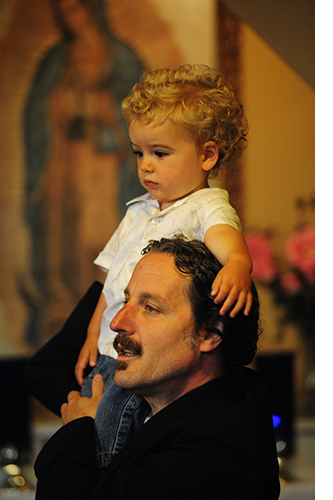
Celebrating 400 years of the Church in California and the Diocese of Santa Rosa
In 1602, one hundred and sixty-seven years before the Franciscans founded the first mission in California and eighteen years before the landing of the Mayflower at New Plymouth,- Spanish explorer Sebastian Vizcaino set out from Acapulco to navigate and explore the California coast for the Spanish crown, under the patronage and protection of Our Lady of Mount Carmel.
Three Discalced Carmelite Friars accompanied the expedition to serve as chaplains to the crew and seek out opportunities for future evangelization of native peoples. According to the journal of Sebastian Vizcaino, on Nov. 10, 1602, the ships sailed into what is now known as San Diego Harbor. Two days later, on the feast day of San Diego de Alcala, a hut was built on land and Father Andres de la Asuncion, Father Antonio de la Ascension and Father Tomas de Aquino celebrated the first recorded Mass in what is now California and the West Coast of the United States.
Continuing his journey up the coast, Vizcaino passed San Francisco Bay on the Feast of the Epiphany, Jan. 6, 1603, and gave the name La Punta de los Reyes (Point of the Three Kings) to the headland we now call Point Reyes. The flagship arrived ay Cape Mendocino (named by the explorer Juan Rodriguez Cabrillo during an earlier expedition) on the Humboldt Coast near present-day Ferndale and Rio Dell on Jan. 13, in the Octave of the Epiphany. It is assumed that, in keeping with the pattern at each coastal landing site, Mass was celebrated at Cape Mendocino. There the expedition split up, with one ship continuing on as far as Cape San Sebastian (in southern Oregon) and the other heading back to Mexico.
Expansion of the Church into Alta California was neglected for more than one hundred fifty years, until Father Junipero Serra founded his first mission in San Diego in 1769. The last of these, Mission San Francisco Solano, established at Sonoma in 1823 by Father Jose Altamira, marked the official foundation of the Church in what would eventually become the Diocese of Santa Rosa.
On the feast day of Santa Rosa de Lima in 1828, Father Juan Amoros was celebrating Mass on a creek bank near the site now occupied by St. Eugene Cathedral. Father Juan noticed a group of Native Americans watching a short distance away and spoke to them of eternal life in Jesus Christ and the necessity of baptism. One young woman came forward and asked to be baptized. As he administered the sacrament, Father Juan gave her the name Rosa and declared that the creek and the entire area henceforth would be known as Santa Rosa. The Asistencia Santa Rosa de Lima, an outpost never declared a mission, was erected on the site; it consisted of a chapel and a residence. From time to time, priests from the missions in Sonoma and San Rafael would come to say Mass for the members of the family of General Vallejo, who settled in the area around 1837.
More and more settlers came into the North Coast region, and parishes and mission churches began to spring up: St. Vincent in Petaluma (1857), St. Bernard in Eureka (1858), St. John the Baptist in Napa (1859), St. Teresa of Avila in Bodega (1861), St. Anthony in Mendocino (1864), St. Helena (1865), St. Patrick in Loleta (1868), St. Joseph in Crescent City (1869), St. Peter in Kelseyville (1870) and St. Mary in Lakeport (1871). As the Catholic population grew, the Diocese of Santa Rosa was created from portions of the Sacramento Diocese and San Francisco Archdiocese in 1962, and now includes 42 parishes and 22 mission churches with about 140,000 members. Diocesan priests and permanent deacons, along with priests, brothers and nuns from more than 20 religious orders serve parishes, schools, Catholic hospitals and do other outreach within the Santa Rosa Diocese.
In celebration of the 400th anniversary of the Church in this diocese and in recognition of the challenges now facing the Church both here and throughout the United States, Bishop Daniel Walsh has called on the Catholics of the Diocese of Santa Rosa to extend the Crusade of Prayer, which began in October, 2001 for a five year period. In so doing, he places this diocese under the special protection of the Blessed Virgin Mary and requests particular prayers to our patron, St. Rose of Lima, for the healing and spiritual growth of the Church. The privilege and duty of prayer, charitable works and evangelization are entrusted to all Catholics; indeed, the laity are specifically called to bring Christ into the world and to pray and work for the transformation of the culture. It is said that when St. Rose,a devout young layperson, died in 1617 an extraordinary reform began in Lima spreading throughout the Americas wherever the Church was present. Sinners repented, charity abounded and scandals ceased. Bishop Walsh has asked us to continue the Crusade of Prayer begun in 2001 in our diocese. May our patroness, St. Rose of Lima, pray with us and for us as we enter the fifth century of the Church in the North Coast.
The spiritual descendants of the friars who accompanied the Vizcaino expedition opened the Carmelite House of Prayer in Oakville (Napa County) in 1955. The House of Prayer offers retreats and spiritual direction and is the center for an active local group of Third Order (lay) Carmelites. Visitors are welcome at daily and Sunday Masses, the First Saturday morning of recollection, or to receive the Sacrament of Reconciliation at any time. Call 944-2454.
